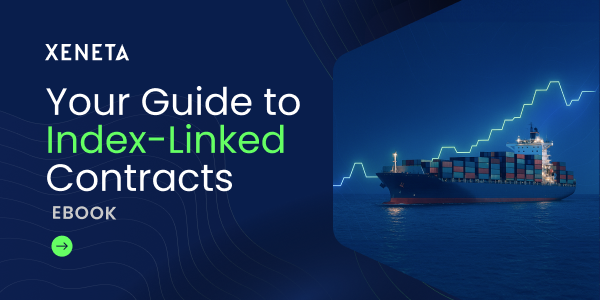10 days ago on 11 May, businesses were caught in a tariff limbo amid dramatic decreases in container shipping demand on the major trade from China to the US.
The fact there is now talk of a spike in freight rates following the announcement of a temporary lowering of tariffs between the US and China demonstrates how quickly situations can come full circle and why it is so difficult for shippers to manage supply chains against such uncertainty.
There will no doubt be further twists and turns, but shippers can use data to gain insight on how freight rates are likely to develop in the coming weeks, along with tactical strategies to manage supply chain risk.
Implications of 90-day window of opportunity
The announcement of a 90-day lowering of US tariffs on Chinese imports from 145% to 30% acted as the starting gun for businesses to ship as many goods as possible during this window of opportunity.
Carriers do not need a second invitation to introduce surcharges in response to situations that cause a squeeze on capacity and this puts shippers in a difficult position.
Everyone is aware of the 90-day window of opportunity as well as the financial implications of missing the deadline for imports. Even if spot rates increase to levels seen during the peak of the Red Sea disruption last year, it would still pale in comparison to the financial impact of tariffs increasing back towards the 145%.
Shippers know this and – perhaps more importantly – so do the carriers as we are already seeing GRIs that push all-in rates to USD 7000 per FEU into the US East Coast for 1 June.
These GRIs may not stick but it gives a clear indication of carrier intentions.
How high will rates go?
There is no doubt shippers are willing to pay higher prices if it ensures their goods arrive in the US during the 90-day window.
We saw this in the immediate aftermath of the ‘Liberation Day’ announcement when some shippers turned to air freight to beat the tariffs. Even the more expensive air mode was financially palatable in comparison to waiting for the tariffs to hit.
The question is therefore what freight rate increase carriers will be able to reasonably demand in the coming weeks.
The answer to this question is not found in the reasonableness of carriers, or even the balance between available shipping capacity and demand. Freight rates will increase to whatever level shippers are willing to pay to ensure their goods are moved.
If some shippers were willing to pay air freight rates to protect supply chains last month, would they not be willing to pay a massive premium for ocean freight this time around?
Data insight
The behavior of shippers can be viewed in the development of freight rates, if we look deeper than average spot rates.
For example, on the trade from China to US West Coast, average spot rates have increased 8% since 14 May, rising from USD 2600 per FEU (40ft container) to USD 2805 per FEU.
It should be noted that average spot rates will climb much higher than 8%. The sudden nature of the US-China tariff announcement meant the immediate priority for shippers has been to get cargo moving - the average spot rate will therefore increase as more shippers renegotiate with carriers at higher prices in the coming days.
What is perhaps more interesting is data in the Xeneta platform that shows spot rates in the mid-high level of the market increased 18% in the same period, from USD 2620 per FEU to USD 3100 per FEU.

The Xeneta mid-high represents rates paid in the 75th percentile of the market. These are highly-likely to be the shippers who reacted quickest to the lowering of the US-China tariffs and were willing to pay higher prices to get their goods moving again.
However, shippers do not need to sacrifice financial prudence to achieve supply chain resilience if they understand the factors that are driving freight rates and the level of the market they should target.
Longer term impact
Uncertainty and fear can have a major impact on freight rates, even in the absence of more tangible factors such as a squeeze on available capacity or port congestion.
We saw freight rates spiral during the Covid-19 pandemic and then again following the escalation of conflict in the Red Sea. Unlike these previous global supply chain shocks, the spike in spot rates resulting from the lowering of tariffs will have a shorter expiration date.
Following a drop in demand during the early months of the pandemic there was an explosion in consumer demand. This time around, the increase in demand is to allow shippers to build up inventories in case tariffs increase again when the 90-day window closes. They may not return to 145%, but would you risk it?
There will not be a major increase in consumer demand in 2025 either. While tariffs are lower, they are still higher than they were previously, so there is every likelihood this will subdue consumer demand.
Once shippers have built up inventories, they will not continue to frontload imports. Demand will therefore ease and carriers will once again be struggling to fill their ships.
This means the traditional Q3 peak season will arrive earlier in 2025, but it should not take too long for spot rates to soften and continue the downward trend seen during Q1.
Carriers may start removing capacity in response – just as they did while the 145% tariffs were in place – but it will probably not be enough to stop rates falling to levels not seen since Q4 2023.
Time to market is key
Understanding these market dynamics is important for shippers who have recently agreed new long term contracts that came into force in May. If they are now looking to frontload imports and this exceeds Minimum Quantity Commitments (MQC) they could be pushed onto the escalating spot market.
Spot market developments in the coming weeks are also hugely significant in determining the best time to market for any shippers who delayed negotiations over new long term contracts.
Clearly, a shipper negotiating during the current spot rate upturn will be in a very different position to one that waits until the decline once the frontloading of imports subsides or carriers flood the market with shipping capacity.
Understanding these market forces allows shippers to use the Xeneta platform to monitor the delta between the short and long term rates and ensure financial efficiency and supply chain assurance.
.png?width=860&height=258&name=Newsletter_BlogCTA%20(1).png)
%201.png)





